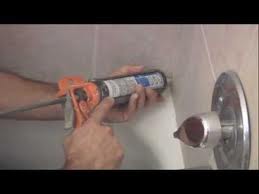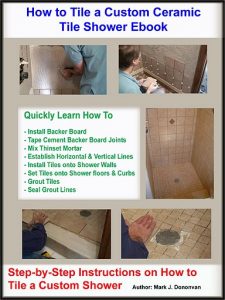Only certain types of Caulk should be used around Tub and Shower Enclosures
By Mark J. Donovan
|
|
Caulk is used around tub and shower units, as well as many other applications, for preventing water from leaking into places that could lead to rot, mold and mildew.
Specifically with tubs and shower units, caulk is used to prevent water from seeping behind them and onto walls and subfloors. Once the water gets behind the tub or shower enclosure it is impossible to wipe up, and it becomes difficult for it to dry out. As a result, rot eventually begins to occur, as well as the formation of mold and mildew. |
Caulk is used for preventing water seepage due to the fact that it is both a glue and sealant. Caulk is also flexible. In addition, it is ideal for forming water tight seals between dissimilar materials, e.g. ceramic tile and fiberglass tubs.
Learn how to caulk around a bathtub and shower and see these videos on caulking around a bathtub and a shower.
There are many types of caulk available on the market today, however not all are appropriate for caulking around tubs and shower enclosures. The most distinguishing characteristic that you need to pay attention to when selecting an appropriate caulk for using around your tub or shower unit is the material that it is made from. For example, there are Polyvinyl Acetate (PVA) caulks, Acrylic latex based caulks, Siliconized Acrylic Latex caulks and 100% silicone caulk.
| Other characteristics you should consider when selecting a caulk is whether or not it is mold and mildew resistance and whether or not it is available in different colors.
Caulking around Fiberglass based Tub/Shower Units If you need to caulk around a fiberglass based tub or shower enclosure it is best to use a 100% silicone caulk. The reason for this is that fiberglass tub or shower units flex more than ceramic or cast iron tub/shower units. |

See this video on caulking around a tub. |
A 100% silicone caulk is more flexible than other types of caulk and thus is less likely to pull away from the fiberglass surface and the connecting surface (e.g. ceramic wall tile, or vinyl flooring).
There are a couple of negatives when using 100% silicone caulk. First, it is terribly difficult to remove from your hands, or any other surface you do not want to have it come in contact with.
| Second, 100% Silicone caulk will not stick to cured existing 100% silicone caulk. As a result, it is imperative to carefully and thoroughly remove all of the old silicone caulk prior to applying new 100% Silicone caulk.
Caulking around Ceramic or Cast Iron Based Tub/Shower Units If the tub or shower surface area is ceramic or cast iron based, use an acrylic latex caulk or a PVA based caulk that is mold and mildew resistant. These types of caulk are easy to work with and will be much easier to remove from your hands and any other surfaces you did not intend for the caulk to be applied to. |

Learn how to tile a shower with this eBook. |
The only downside of using these types of caulk is that they are less flexible than the 100% silicone caulk and thus could pull away from the tub or shower enclosure if there is significant deflection in the flooring or surrounding walls.
For help on your bathroom remodeling project, see my Bathroom Remodeling Bid Sheet. The Bathroom Remodeling Bid Sheet provides a request for quote checklist section that you can provide to prospective bathroom remodeling contractors. It also includes a comprehensive bathroom remodeling cost breakdown table, in Microsoft Excel format, that allows the contractor to include his projected remodeling costs for every phase of the project.
Related Information
Additional Bathroom Remodeling Design Resources
 |
 |
Get Free Bathroom Remodeling Price Quotes with No Obligation!
Fill out our 3-5 minute quick and easy form, and receive a free price quote on bathroom remodeling from one of our prescreened and licensed bathroom remodeling contractors. This process is free and there is no obligation to continue once you receive your bathroom renovation price estimate.
